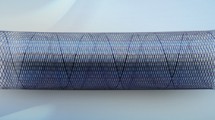Abstract
Introduction
A remarkable curing rate has been achieved in the treatment of intracranial intractable aneurysms by using flow-diverting stents (FDS). An appropriate metal coverage (MC) of this device influences the hemodynamics of aneurysm significantly but little to branches in vitro. The MC changes after elongation or compression and the actual changes are still unknown in vivo. In this paper, we analyzed the correlation of aneurysm occlusion with actual MC after implantation of FDS in rabbit models.
Methods
FDS was implanted across the necks of 22 elastase-induced aneurysms in rabbits. Animals were performed for angiography at 4 weeks and sacrificed at 3 months after angiography for pathology. Tissue was explanted with stent for micro-computed tomography scan, and local shape of stent at neck was reconstructed. Actual MC at neck was calculated, and the correlations of aneurysm occlusion with effective factors were analyzed.
Results
Greater than 95% angiographic aneurysm occlusion rates for the FDS, which covered the neck of aneurysms, were 61.9% at 4 weeks and 57.9% by angiography at 3 months. Aneurysm occlusion was positively correlated with local MC of stent at neck (r s = 0.486; P = 0.026). A 35% actual MC at the neck predicted greater than 95% angiographic aneurysm occlusion with a specificity of 100% and sensitivity of 53.8%.
Conclusion
Aneurysm occlusion was positively correlated with local MC of stent at the neck. The FDS with 35% MC can predict greater than 95% angiographic aneurysm occlusion.




Similar content being viewed by others
References
Raymond J, Guilbert F, Weill A et al (2003) Long-term angiographic recurrences after selective endovascular treatment of aneurysms with detachable coils. Stroke 34:1398–1403
Campi A, Ramzi N, Molyneux AJ et al (2007) Retreatment of ruptured cerebral aneurysms in patients randomized by coiling or clipping in the International Subarachnoid Aneurysm Trial (ISAT). Stroke 38:1538–1544
Wakhloo AK, Schellhammer F, de Vries J et al (1994) Self-expanding and balloon-expandable stents in the treatment of carotid aneurysms: an experimental study in a canine model. AJNR Am J Neuroradiol 15:493–502
Seong J, Wakhloo AK, Lieber BB (2007) In vitro evaluation of flow diverters in an elastase-induced saccular aneurysm model in rabbit. J Biomech Eng 129:863–872
Fiorella D, Woo HH, Albuquerque FC et al (2008) Definitive reconstruction of circumferential, fusiform intracranial aneurysms with the pipeline embolization device. Neurosurgery 62:1115–1120, discussion 1120–1121
Fiorella D, Kelly ME, Albuquerque FC et al (2009) Curative reconstruction of a giant midbasilar trunk aneurysm with the pipeline embolization device. Neurosurgery 64:212–217, discussion 217
Lylyk P, Miranda C, Ceratto R et al (2009) Curative endovascular reconstruction of cerebral aneurysms with the pipeline embolization device: the Buenos Aires experience. Neurosurgery 64:632–642, discussion 642–643
Fiorella D, Kelly M, Woo H (2009) Flow diversion for intracranial aneurysm treatment. Endovasc Today 67–74
Wang K, Huang Q, Hong B et al (2009) Neck injury is critical to elastase-induced aneurysm model. AJNR Am J Neuroradiol 30:1685–1687
Kallmes DF, Ding YH, Dai D et al (2007) A new endoluminal, flow-disrupting device for treatment of saccular aneurysms. Stroke 38:2346–2352
Kallmes DF, Ding YH, Dai D et al (2009) A second-generation, endoluminal, flow-disrupting device for treatment of saccular aneurysms. AJNR Am J Neuroradiol 30:1153–1158
Kole MK, Pelz DM, Kalapos P et al (2005) Endovascular coil embolization of intracranial aneurysms: important factors related to rates and outcomes of incomplete occlusion. J Neurosurg 102:607–615
Molyneux A, Kerr R, Stratton I et al (2002) International Subarachnoid Aneurysm Trial (ISAT) of neurosurgical clipping versus endovascular coiling in 2143 patients with ruptured intracranial aneurysms: a randomized trial. J Stroke Cerebrovasc Dis 11:304–314
Sadasivan C, Cesar L, Seong J et al (2009) Treatment of rabbit elastase-induced aneurysm models by flow diverters: development of quantifiable indexes of device performance using digital subtraction angiography. IEEE Trans Med Imaging 28:1117–1125
Aurboonyawat T, Blanc R, Schmidt P et al (2011) An in vitro study of silk stent morphology. Neuroradiology 53:659–667
Appelboom G, Kadri K, Hassan F et al (2010) Infectious aneurysm of the cavernous carotid artery in a child treated with a new-generation of flow-diverting stent graft: case report. Neurosurgery 66:E623–E624, discussion E624
Aurboonyawat T, Schmidt PJ, Piotin M et al (2011) A study of the first-generation pipeline embolization device morphology using intraoperative angiographic computed tomography (ACT). Neuroradiology 53:23–30
Liu JM, Zhao WY, Zhang X et al (2007) Pathology of stented common carotid aneurysm in dogs comparison between stenting and stent-assisted coiling. Intervent Neuroradiol 11:333–340
Liou TM, Liou SN, Chu KL (2004) Intra-aneurysmal flow with helix and mesh stent placement across side-wall aneurysm pore of a straight parent vessel. J Biomech Eng 126:36–43
Lieber BB, Livescu V, Hopkins LN et al (2002) Particle image velocimetry assessment of stent design influence on intra-aneurysmal flow. Ann Biomed Eng 30:768–777
Kulcsár Z, Ernemann U, Wetzel SG et al (2010) High-profile flow diverter (silk) implantation in the basilar artery: efficacy in the treatment of aneurysms and the role of the perforators. Stroke 41:1690–1696
Szikora I, Berentei Z, Kulcsar Z et al (2010) Treatment of intracranial aneurysms by functional reconstruction of the parent artery: the Budapest experience with the pipeline embolization device. AJNR Am J Neuroradiol 31:1139–1147
Lubicz B, Collignon L, Raphaeli G et al (2010) Flow-diverter stent for the endovascular treatment of intracranial aneurysms: a prospective study in 29 patients with 34 aneurysms. Stroke 41:2247–2253
Acknowledgments
This study was supported by the National Natural Science Foundation of China (Grant No. 30901556) and Shanghai Committee of Science and Technology Foundation (Grant No. 08JC1406400). We gratefully thank MicroPort Medical (Shanghai) Co. Ltd. for the free flow-diverting stents.
Conflict of interest
We declare that we have no conflict of interest.
Author information
Authors and Affiliations
Corresponding author
Additional information
Dr. Kuizhong Wang and Bo Hong are co-first authors.
Rights and permissions
About this article
Cite this article
Wang, K., Huang, Q., Hong, B. et al. Correlation of aneurysm occlusion with actual metal coverage at neck after implantation of flow-diverting stent in rabbit models. Neuroradiology 54, 607–613 (2012). https://doi.org/10.1007/s00234-011-0922-7
Received:
Accepted:
Published:
Issue Date:
DOI: https://doi.org/10.1007/s00234-011-0922-7




